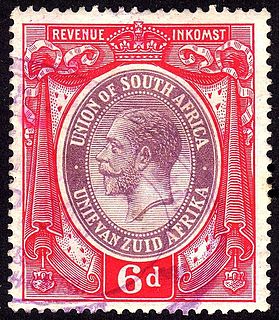
The Orange Free State was an independent Boer republic in southern Africa during the second half of the 19th century.
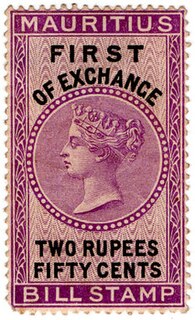
Mauritius issued revenue stamps from 1 March 1869 to 1904. There were various types of fiscal stamps for different uses.
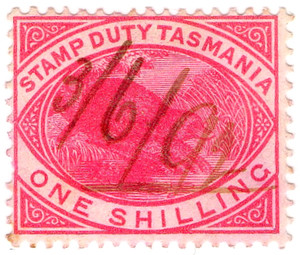
The Australian State of Tasmania issued adhesive revenue stamps from 1863 to 1998, although impressed stamps had appeared briefly in the 1820s. There were general revenue and stamp duty issues, as well as a number of specific issues for various taxes.

The island of Cyprus first issued revenue stamps in 1878 and continues to do so to this day. The Turkish Republic of Northern Cyprus also issues its own revenue stamps.
British Honduras issued revenue stamps in 1899. The only issue consisted of contemporary postage stamps overprinted "REVENUE". Four values exist - 5c, 10c, 25c and 50c on 1s, and there are two different sizes of the overprint - 11mm and 12mm long. Additionally there are a number of varieties in the overpint which are very collectible, such as "BEVENUE", "REVENU " and "REVE UE". Despite being intended for fiscal use, they were also valid for postal use.
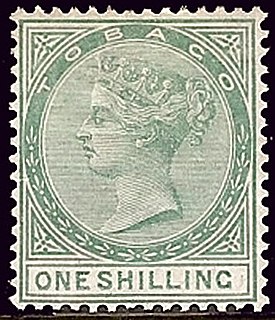
Trinidad and Tobago, formerly divided as two separate colonies, issued revenue stamps from 1879 to around 1991.

British Guiana, now known as Guyana, first issued revenue stamps in 1865 and continues to do so to this day.
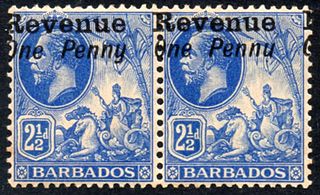
The island of Barbados first issued revenue stamps in 1916. There were various types of fiscal stamps for different taxes.
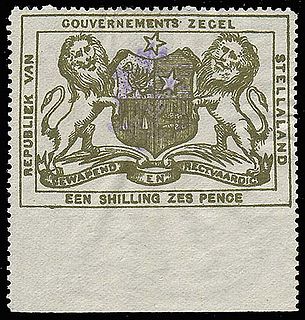
Bechuanaland first issued revenue stamps as Stellaland in 1884. Note: this information is wrong. Bechuanaland was split into British Bechuanaland and the Bechuanaland Protectorate. British Bechuanaland was added to the Cape Colony and the Bechuanaland Protectorate was governed from Mafeking until the seat of government was moved to Gaberone.

The South African Republic (ZAR), later known as Transvaal issued revenue stamps from 1875 to around 1950. There were a number of different stamps for several taxes.

New Zealand first issued revenue stamps on 1 January 1867 and their general use continued until the early 1950s. The only Revenue Stamp series still in use today is the Game Bird Habitat stamp which is used for payment of the Gun License for the duck shooting season which begins the first weekend of May. There were various types of fiscal stamps for different taxes.

Nyasaland, now known as Malawi, first issued revenue stamps as British Central Africa in 1891 and continued to do so until the late 1980s.

Rhodesia, now divided between Zambia and Zimbabwe, first issued revenue stamps in 1890, and Zimbabwe continues to do so to this day.

Hong Kong issued revenue stamps from 1867 to the 1990s, both when it was a British colony as well as when it was under Japanese occupation.

Over the years various Malay States issued their own revenue stamps. Now most states use Malaysian revenue stamps, except for Singapore which is independent and no longer uses revenue stamps.
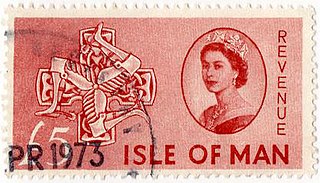
Revenue stamps of the Isle of Man refer to the adhesive revenue or fiscal stamps which were issued by the British Crown dependency of the Isle of Man between 1889 and 1976. British key type revenue stamps with an appropriate inscription were issued on the island until 1966, when revenue stamps showing various scenes and symbols of the island began to be issued. The last set of stamps was issued in 1976. From around 1920 to the 1970s, hundreds of contribution stamps were issued for National Insurance and related schemes.
Revenue stamps of Fiji were first issued in 1871, when the Fiji islands were an independent kingdom. The first revenue stamps consisted of postage stamps overprinted with the letter D.
Few revenue stamps of Nigeria and its predecessor states have been issued, since most of the time dual-purpose postage and revenue stamps were used for fiscal purposes. The first revenue-only stamps were consular stamps of the Niger Coast Protectorate and the Southern Nigeria Protectorate, which were created by overprinting postage stamps in 1898 and 1902 respectively. The Northern Nigeria Protectorate did not issue any specific revenue stamps, but a £25 stamp of 1904 could not be used for postal purposes due to its extremely high face value.




